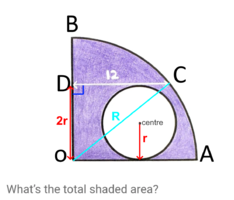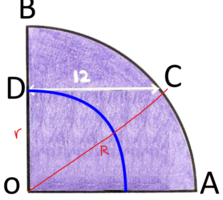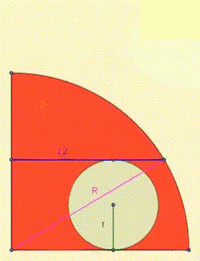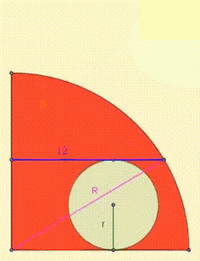You are using an out of date browser. It may not display this or other websites correctly.
You should upgrade or use an alternative browser.
You should upgrade or use an alternative browser.
This may be an old problem - from Quora
- Thread starter khansaheb
- Start date
Dr.Peterson
Elite Member
- Joined
- Nov 12, 2017
- Messages
- 16,865
Using very little geometry, together with the assumption that there is an answer (a fixed number not dependent on the facts we don't know), it's easy to give an answer: Just pick a very simple size for the white circle ...View attachment 35971
What's the area of the total shaded region?
Given:
- AOB is a quarter cycle
- OA || DC
- DC = 12 (any unit - cm or in or mile or whatever you want)
This problem could be solved without knowing "almost" any geometry or algebra.
I've learned, though, not to trust that there actually is an answer to every question; sometimes there just isn't enough data, or the question was stated incorrectly. So I don't like that approach, as elegant as it is.
There is another easy way to get an answer with no written work, which uses the Pythagorean Theorem applied to triangle OCD. To use it directly, I have to use the fact that the area of a circle is the same as that of a quadrant of a circle whose radius is the diameter of the given circle. Does that count as using geometry?
The Highlander
Senior Member
- Joined
- Feb 18, 2022
- Messages
- 1,203
Shaded Area = 36π cm2 or in2 or square miles or whatever you want. ?View attachment 35971
What's the area of the total shaded region?
Given:
- AOB is a quarter cycle
- OA || DC
- DC = 12 (any unit - cm or in or mile or whatever you want)
This problem could be solved without knowing "almost" any geometry or algebra.
The Highlander
Senior Member
- Joined
- Feb 18, 2022
- Messages
- 1,203
Pursuing @Dr.Peterson's "hints" my solution was...
Consider the complete (purple) circle that AOB is a quadrant of; its area would be πR² therefore the area of the quadrant (AOB) is ¼πR².
The area of the smaller, white circle is πr², therefore, the Shaded Area = ¼πR² - πr².
But the length OD is 2r, therefore, by Pythagoras:-
R² - 4r² = 12² = 144
If we multiply both sides by π, we get:-
πR² - 4πr² = 144π
and dividing throughout by 4 gives:-
¼πR² - πr² = 36π
but, as shown above, ¼πR² - πr² is the Shaded Area
Therefore, the Shaded Area = 36π cm² or in² or square poronkusemaa ? or whatever else you prefer.
QED ?
Dr.Peterson
Elite Member
- Joined
- Nov 12, 2017
- Messages
- 16,865
My quick way was to shrink the white circle down to nothing, so that the radius of the large circle is 12 units; then the shaded area is 1/4 of pi times 12 squared, which is ... 36 pi square units.
My visual way was to reshape it as an annulus (in which form it is definitely an old problem):
So the shaded area is 1/4 pi R^2 - 1/4 pi r^2 = 1/4 pi 12^2 = 36 pi square units.
(I'm not using Latex because the whole point is to minimize the work.)
My visual way was to reshape it as an annulus (in which form it is definitely an old problem):
So the shaded area is 1/4 pi R^2 - 1/4 pi r^2 = 1/4 pi 12^2 = 36 pi square units.
(I'm not using Latex because the whole point is to minimize the work.)
The Highlander
Senior Member
- Joined
- Feb 18, 2022
- Messages
- 1,203
Like this....My quick way was to shrink the white circle down to nothing, so that the radius of the large circle is 12 units; then the shaded area is 1/4 of pi times 12 squared, which is ... 36 pi square units.
Love it! ?
The Highlander
Senior Member
- Joined
- Feb 18, 2022
- Messages
- 1,203
That is within the bounds of "almost " no geometry.....Does that count as using geometry?





